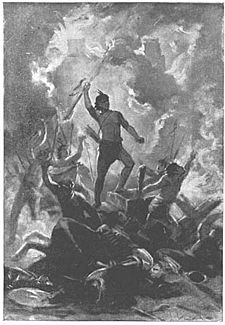Caupolicán facts for kids
Caupolicán was a brave war leader of the Mapuche people. His name means 'polished flint' or 'blue quartz stone' in their language, Mapudungun. He led his people's fight against the Spanish Conquistadors. These Spanish invaders came to the land we now call Chile in the 1500s. Caupolicán was the Mapuche war leader, or toqui, from about 1553 to 1558 AD.
Contents
Who was Caupolicán?
Caupolicán was a serious and respected leader. He was blind in one eye since he was a child. His main wife was named Fresia, though some stories call her Gueden or Paca. He had one son, named Lemucaguin, also known as Caupolicán the Younger.
Early Life and Battles
Caupolicán fought against the Spanish from a young age. He helped his people try to stay free. He became the Toqui after another great leader, Lautaro, passed away. Some stories say he was chosen secretly by an older chief named Colo Colo.
The Mapuche people were very strong and resisted the Spanish invaders in southern Chile. Caupolicán and Lautaro were key leaders in the Arauco War during the 1500s. Caupolicán helped Lautaro in the Battle of Tucapel. In this battle, the Mapuche defeated the Spanish army. Their leader, Pedro de Valdivia, was killed.
Caupolicán became a symbol of Native American strength and resistance. His life story was told in a famous poem called La Araucana by Alonso de Ercilla. Another poet, Ruben Dario, also wrote about him.
Battle of Lagunillas
After Lautaro's death, the Mapuche needed a strong leader. In the battle of Lagunillas on September 5, 1557, a large Mapuche army fought the Spanish. The Mapuche had 12,000 warriors, led by several Toquis like Lincoyan and Galvarino. The Spanish army, led by Garcia Hurtado de Mendoza, had 600 soldiers and 1500 yanakunas (Native Americans who helped the Spanish).
The Mapuche attack was not well organized. Even though they had more fighters, they lost the battle. Many Mapuche warriors were killed or hurt, and 150 were captured.
How Caupolicán Became Toqui
After these defeats, the Mapuche leaders met in the Pilmaiquen Mountains. They wanted to choose one strong leader to unite their army. Caupolicán was chosen as Toqui. He was known for his amazing physical strength and bravery.
To prove his strength, Caupolicán had to hold a heavy tree trunk on his shoulders. He held it for two days and one night without falling! This showed the other chiefs, like Tucapel, Rengo, and Colo Colo, that he was the right choice. He beat other candidates like Paicavi, Lincoyan, and Elicura. This amazing event was written about in the poem La Araucana.
Battle of Millarapue
After their win at Lagunillas, the Spanish moved deeper into Mapuche land. They camped at Millarapue on November 29. Caupolicán planned a surprise attack on the Spanish camp for the morning of November 30.
But by chance, the Spanish soldiers were celebrating a holiday. They sounded a trumpet call, which the Mapuche mistook for an alarm. They thought they had been discovered, and their surprise attack was ruined. About 15,000 Mapuche warriors attacked. The battle of Millarapue lasted all morning until the afternoon. Caupolicán led the fight from a white horse. In the end, the Mapuche were surrounded and defeated. After this, the Spanish built the Cañete fort near the old Tucapel fort.
Battle of Cañete Fort
On January 20, 1558, the Mapuche army, led by Caupolicán, surrounded the Spanish fort at Cañete. There were over 15,000 Mapuche warriors. Caupolicán wanted to starve the Spanish inside the fort.
The situation was very difficult for the Spanish. Fighting outside the fort meant certain defeat. Attacking the strong fort directly would cause many Mapuche deaths. Then, a yanakuna named Andresillo offered a plan. He pretended to be a Spanish deserter and befriended the Mapuche. He told them the best time to attack was during the Spanish siesta (afternoon nap). He promised to open the fort doors for them.
Caupolicán sent a spy to check Andresillo's story. The Spanish captain, Alonso de Reinoso, knew about the spy. He told his soldiers to pretend to be asleep. On February 5, Andresillo opened the doors. A group of Mapuche entered quietly. But once most of the army was inside, the Spanish opened fire! Many Mapuche were killed, and they ran away in a panic. Caupolicán managed to escape because the Spanish cavalry had not yet arrived. When the cavalry did arrive, the Mapuche retreated into the hills.
Death of Caupolicán
While the Mapuche forces were still retreating, a Spanish group found Caupolicán. This happened at the Battle of Antihuala on February 5, 1558. Caupolicán was planning another attack when he was captured. He was taken to Captain Alonso de Reinoso, who ordered him to be executed by impalement.
Caupolicán's Legacy
Many people see Caupolicán as a very fierce warrior. Even though he didn't win as many battles as Lautaro, he is still greatly admired. Today, Caupolicán is honored all over Chile. Streets, theaters, parks, and monuments are named after him. There is a famous bronze statue on Santa Lucia hill in Santiago. Many people believe it is a tribute to Caupolicán, and it has become a popular symbol of him.
See also
 In Spanish: Caupolicán para niños
In Spanish: Caupolicán para niños
- Pedro De Valdivia
- Arauco War
- Lautaro
- Alonso De Ercilla
- Lincoyan
- Lemucaguin
- Alonso De Reinoso
- Jeronimo De Vivar
- Alonso De Gongora Marmolejo
- Pedro Mariño De Lobera
Sources


